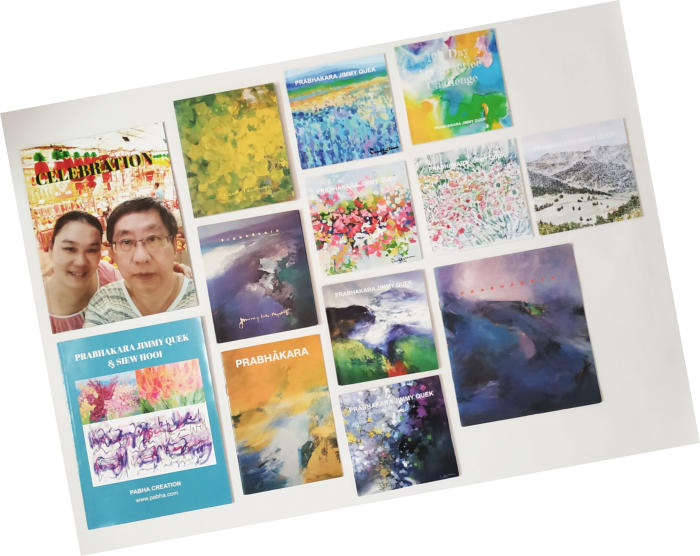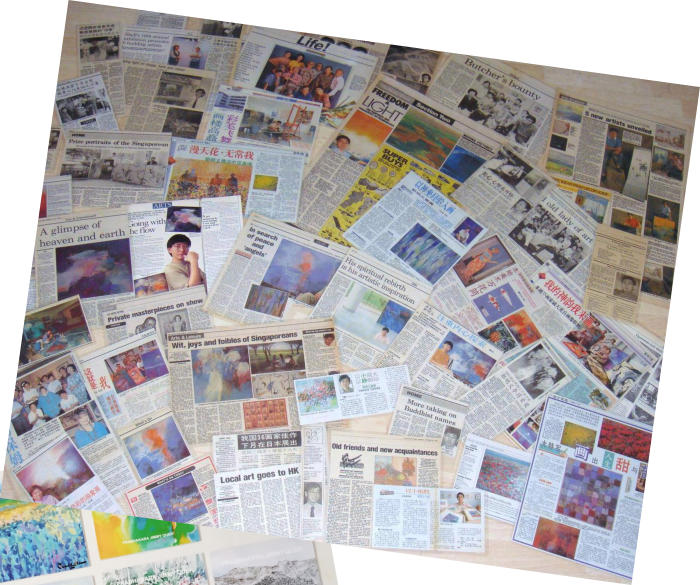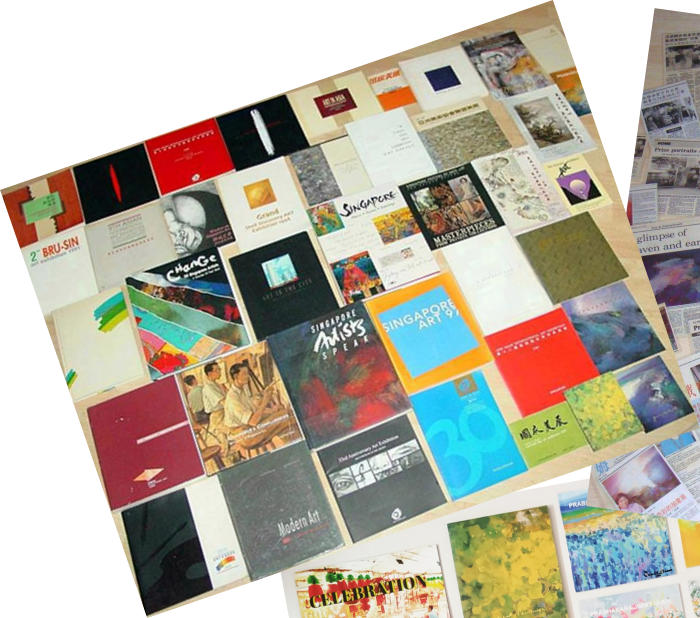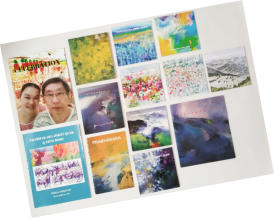Jimmy's Works
By Carol Jacobi
Text extracted from First One-man Art Exhibition Catalogue - Prabhakara 1987.
Art in Singapore is noteworthy for its understanding of the abstract
possibilities of two dimensional form, and for its pursuit of beauty and
uplifting spiritual values. Both of these abound in the work of Jimmy
Quek, but are combined with an exhilarating sense of colour.
Beauty in nature and the movement and change which is life, are
recurring subjects in this artist's work. Water is featured in many
pieces, but differently each time. In Wave, power and grandeur are
communicated by the scale and grandeur of the composition, the
strength of gesture and richness of blue pigment. The contrasting
delicacy of the merest touch of white spray enhances the above, and
adds a fleeting temporal quality.
The transience and mutability, the infinite possibilities of change and
movement in water, fascinates the artist. In Water, Life, Mercurial 2 and
Rock, the paint itself dashes across the canvas, rebounds or flurries
into subtle configurations of mist and spray, and sometimes seems to
evaporate away altogether.
But Jimmy claims no desire to limit himself to one style 'simply for the
convenience of being easily recognized by a public', and Aerial View 2
is one striking example of his considered flexibility. It differs from his
looser pieces, being broad, calm and strongly figurative. Unlike many
artists, Jimmy has not left figurative interests behind as he developed
towards the abstract. This recent work combines both. The idea of
openness and serenity is produced directly by the picturesque view of
patchwork fields, but the effect is enhanced by gentle harmonies of
greens, and the sense of flatness communicated by the high horizon
and by the smooth texture of the paint itself. The meandering curves of
the river give life and movement to the composition, just as they give
life in reality to the surrounding country.
In other works, Jimmy's unusual impasto technique often tempts the
viewer to enjoy the interaction of the layers and colour and texture and
shape of paint, as well as whatever reality they might suggest. In
several compositions, he replaces the traditionally dark line with a
lighter, brighter one. A fluid gesture in chrome orange or an outline in
crimson can thus interact as colour, as well as defining shape and
movement.
Such experiments highlight Jimmy's general preoccupation and
sensitivity with colour. Works like Untitled and Aerial View 2 show a
mastery of the cool, muted harmonious tones and mood popular in
Singapore art. The equally traditional red, of Chinese New Year, Guo Tai
Min An and Causation is handled with both spirit and the control
necessary for this difficult shade. It does not become heavy or over-
dominant, yet retains its potency. One way Jimmy achieves this is to
juxtapose equally vivid colours, orange or Paris blue, which
simultaneously compete with and enhance the red.
Colour is never merely factual. It plays a part in composition, as in The
Fairground, where the dynamics of the colour reconcile the difficult
relationship between the circular and rectangular shapes. In Guo Tai
Min An irrelevant foreground objects
Here, and in his purer abstract works, the vivacity of colour becomes an
end in itself. In the latter, Jimmy is free to exhibit more idiosyncratic
orchestrations of colour. He tries unusual combinations of colour. He
tries unusual combinations; for example, Paris Blue, rust and moss
green. He shows an interest in giving conventionally gentle shades,
pastel yellow, pink or turquoise, a greater impact by brushing them
broadly over the last layers. The result, as in Surf, is an exciting tension
and contradiction of expectations, as the softness of the colour itself
counterpoints its own strength of gesture, or a delicate shade
confronts a vivid one.
Despite the apparent range of subjects and styles presented by this
young artist, most of his works distinguish themselves in terms of
almost musical sensitivity to abstract pleasures and colour, shape and
movement, yet keep a foothold in the figurative. The delightful balance
between the two can tantalize and provoke us. Even the least figurative,
such as Mercurial II, include a horizontal strip at the top to introduce an
illusive suggestion of a landscape, whereas Rock has been signed on
the back so that it can either remain true to its title, or be hung another
way up.
Jimmy continues the picturesque and abstract tradition of painting in
Singapore, and provides a welcome splash of colour, dynamism, and a
reassuring curiosity.
1987







Jimmy's Works
By Carol Jacobi
Text extracted from First One-man Art Exhibition Catalogue -
Prabhakara 1987.
Art in Singapore is noteworthy for its
understanding of the abstract possibilities of
two dimensional form, and for its pursuit of
beauty and uplifting spiritual values. Both of
these abound in the work of Jimmy Quek, but
are combined with an exhilarating sense of
colour.
Beauty in nature and the movement and
change which is life, are recurring subjects in
this artist's work. Water is featured in many
pieces, but differently each time. In Wave,
power and grandeur are communicated by the
scale and grandeur of the composition, the
strength of gesture and richness of blue
pigment. The contrasting delicacy of the
merest touch of white spray enhances the
above, and adds a fleeting temporal quality.
The transience and mutability, the infinite
possibilities of change and movement in water,
fascinates the artist. In Water, Life, Mercurial 2
and Rock, the paint itself dashes across the
canvas, rebounds or flurries into subtle
configurations of mist and spray, and
sometimes seems to evaporate away
altogether.
But Jimmy claims no desire to limit himself to
one style 'simply for the convenience of being
easily recognized by a public', and Aerial View 2
is one striking example of his considered
flexibility. It differs from his looser pieces,
being broad, calm and strongly figurative.
Unlike many artists, Jimmy has not left
figurative interests behind as he developed
towards the abstract. This recent work
combines both. The idea of openness and
serenity is produced directly by the
picturesque view of patchwork fields, but the
effect is enhanced by gentle harmonies of
greens, and the sense of flatness
communicated by the high horizon and by the
smooth texture of the paint itself. The
meandering curves of the river give life and
movement to the composition, just as they give
life in reality to the surrounding country.
In other works, Jimmy's unusual impasto
technique often tempts the viewer to enjoy the
interaction of the layers and colour and texture
and shape of paint, as well as whatever reality
they might suggest. In several compositions, he
replaces the traditionally dark line with a
lighter, brighter one. A fluid gesture in chrome
orange or an outline in crimson can thus
interact as colour, as well as defining shape
and movement.
Such experiments highlight Jimmy's general
preoccupation and sensitivity with colour.
Works like Untitled and Aerial View 2 show a
mastery of the cool, muted harmonious tones
and mood popular in Singapore art. The
equally traditional red, of Chinese New Year,
Guo Tai Min An and Causation is handled with
both spirit and the control necessary for this
difficult shade. It does not become heavy or
over-dominant, yet retains its potency. One
way Jimmy achieves this is to juxtapose equally
vivid colours, orange or Paris blue, which
simultaneously compete with and enhance the
red.
Colour is never merely factual. It plays a part in
composition, as in The Fairground, where the
dynamics of the colour reconcile the difficult
relationship between the circular and
rectangular shapes. In Guo Tai Min An
irrelevant foreground objects
Here, and in his purer abstract works, the
vivacity of colour becomes an end in itself. In
the latter, Jimmy is free to exhibit more
idiosyncratic orchestrations of colour. He tries
unusual combinations of colour. He tries
unusual combinations; for example, Paris Blue,
rust and moss green. He shows an interest in
giving conventionally gentle shades, pastel
yellow, pink or turquoise, a greater impact by
brushing them broadly over the last layers. The
result, as in Surf, is an exciting tension and
contradiction of expectations, as the softness
of the colour itself counterpoints its own
strength of gesture, or a delicate shade
confronts a vivid one.
Despite the apparent range of subjects and
styles presented by this young artist, most of
his works distinguish themselves in terms of
almost musical sensitivity to abstract pleasures
and colour, shape and movement, yet keep a
foothold in the figurative. The delightful
balance between the two can tantalize and
provoke us. Even the least figurative, such as
Mercurial II, include a horizontal strip at the
top to introduce an illusive suggestion of a
landscape, whereas Rock has been signed on
the back so that it can either remain true to its
title, or be hung another way up.
Jimmy continues the picturesque and abstract
tradition of painting in Singapore, and provides
a welcome splash of colour, dynamism, and a
reassuring curiosity.
1987


























